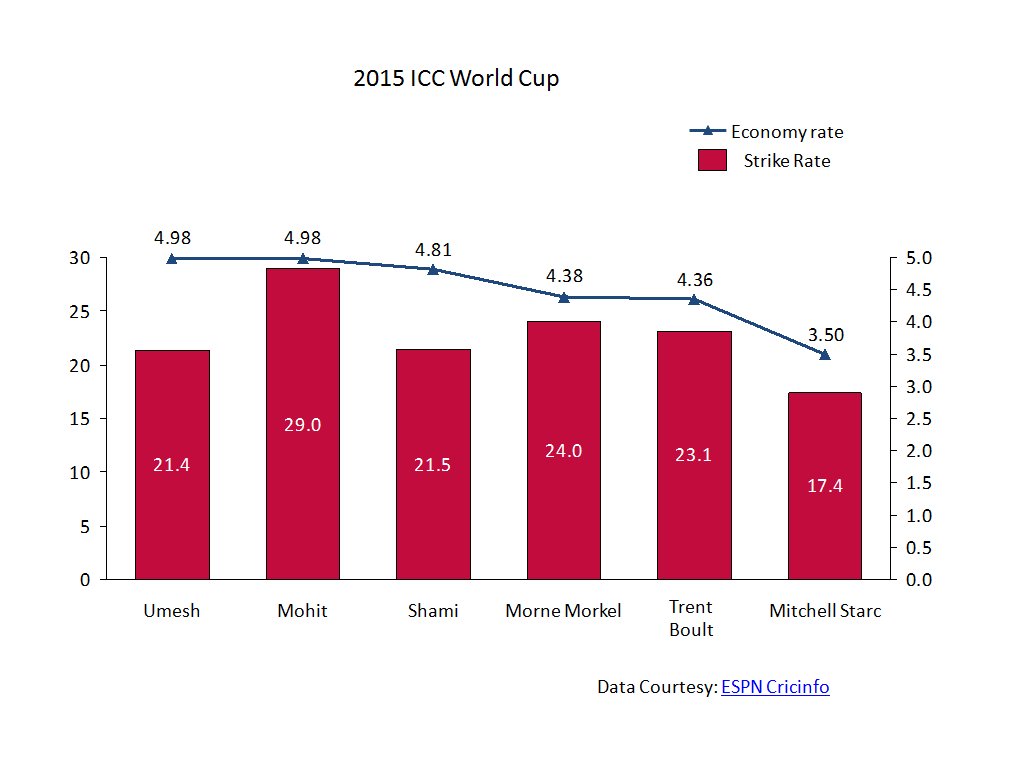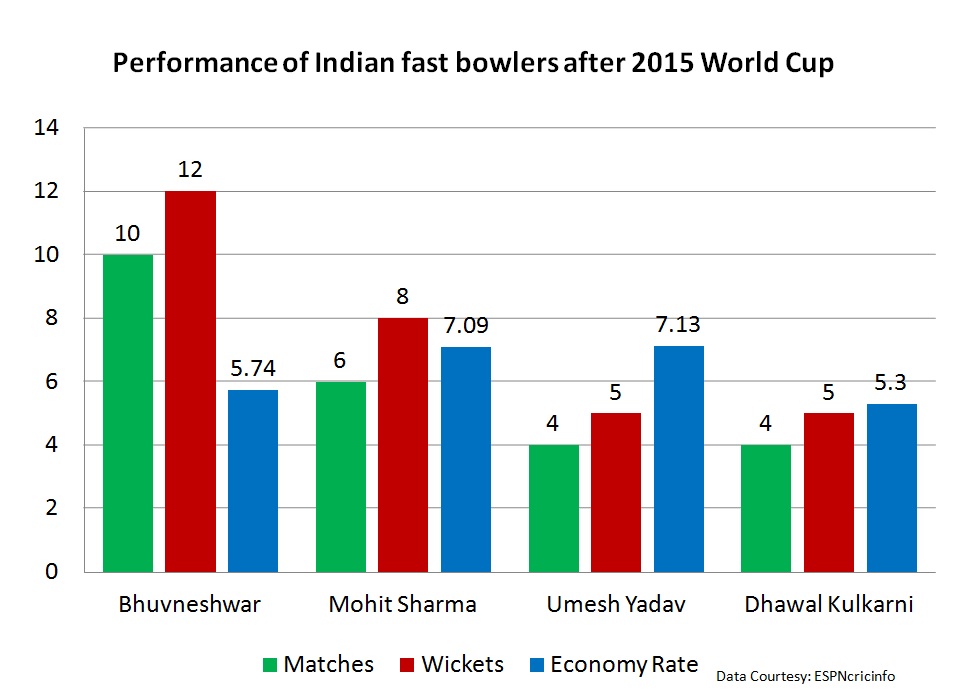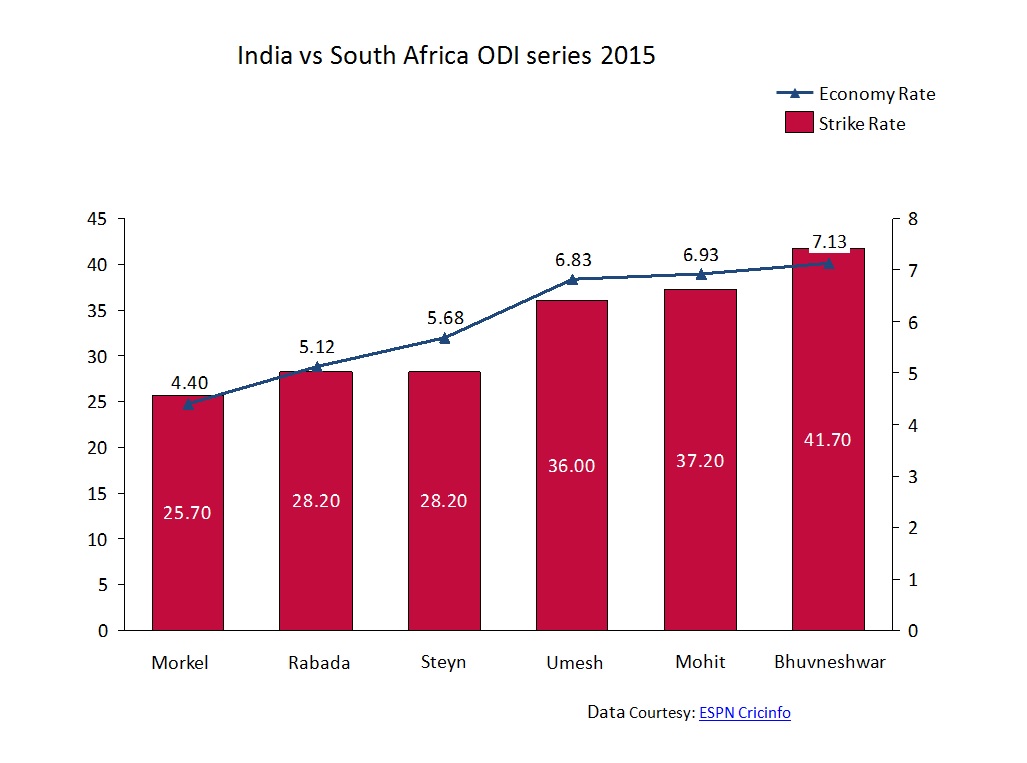Indian cricket’s “strike bowler” syndrome
As the dust settles down on the pitch debate, the Indian cricket team is embarking on a trip down-under to start another phase in coloured clothing. The biggest question confronting the captain, the selectors or the average cricket fan won’t be R Ashwin’s form or the batsmen’s ability to play the short balls; it will be the riddle we try to solve before every tour abroad – the fast bowling.
India’s last experience on the Australian soil came in the 2015 ICC World Cup, where our fast bowlers exceeded expectations. Mohammed Shami (17), Umesh Yadav (18) and Mohit Sharma (13) combined to pick up 48 wickets to lead India to the semi-final before crashing out against the eventual champions Australia. The attack also bowled out all their opponents in the tournament except in that semi-final match-up. A look at the numbers from the World Cup will show you how our pacers stood shoulder-to-shoulder with the world’s best.

However, the story after the World Cup can only be termed as below average with India suffering series defeats against Bangladesh (1-2) and South Africa (2-3). Their only ODI series win of the year came in the away tour against Zimbabwe (3-0).
In both series defeats, India started as the favourites with an explosive batting line-up and spinners in the armoury. As the story unfolded, in both cases, the pace bowlers turned out to be the highest wicket-takers. If Mustafizur Rahman with 13 wickets in three matches was the star for Bangladesh, Kagiso Rabada (10) and Dale Steyn (10) did the job for the Proteas. (Read: Ashwin – superstar bowler in the making)
Indian pacers, on the other hand, went back to the old story of conceding truck load of runs and lack of wickets. Bhuvneshwar, Umesh, Mohit and Dhawal Kulkarni performed fast bowling duties for India in the last ten ODIs after the World Cup and the numbers do not shower any of them in glory.

Bhuvneshwar Kumar’s dip in form and his shift away from the ‘big banana swing’, which bamboozled the batsmen, has led to his ouster from the team for the tour down-under. Mohit Sharma, who had a good 2015 World cup campaign, has also been unable to replicate the success on Indian pitches. He too didn’t made the cut for the Australia tour with an injury ruling him out. Dhawal Kulkarni’s cameo appearances in Bangladesh and Zimbabwe remained his contribution to the team as he too has been left out of the Australia tour.
Then there is Umesh Yadav, who made it to the Australia tour after being dropped twice since the World Cup - for the Zimbabwe tour and for the last two ODIs against South Africa.
So, the question would be what happened to the Indian fast bowlers after the World Cup?
"If you see any other Test or ODI-playing nation, the fast bowlers come and in one or two years they graduate to the next level - they become the strike bowlers or they learn what their strength is and bowl according to that,
To some extent, we have not been able to do that ...." lamented Dhoni after the fifth ODI in Mumbai, where South Africa plundered 438 runs in 50 overs. (Read: Mahendra Singh Dhoni- From maverick to India's greatest captain)
The most obvious reason will be the lack of friendly pitches for the fast bowlers. But a counter to that will be the performance of South African pacers in the series against India. Steyn and Morkel are world class bowlers and will trouble batsmen in any wicket, but the performance of the rookie pacer Kagiso Rabada shows the real picture.

The captain’s cry for a “strike bowler” seems justified after going through the numbers of the pacers since the World cup. So let’s look ahead, the Australia tour,
"If you have to do well in Australia, you have to pick up wickets. If you see all the brilliant Indian wins in Australia, it was because bowlers picked up wickets. When that happens in Australia, invariably you win matches.
"If you're not taking wickets early on, or in the middle overs, then you're going to get hammered by the Australians at the death. To beat Australia, the formula is to take wickets," said VVS Laxman about India’s chances down-under.
The responsibility to take wickets early on in the match rests on the fast bowlers, and that responsibility will be handled by Umesh Yadav along with Mohammed Shami, Ishant Sharma and rookie Brainder Sran. (Read: Yuvraj Singh - The Merchant of Dreams)
On paper, the pace line-up looks formidable. Shami and Umesh were India’s best bowlers in the 2015 World Cup. Ishant Sharma is the leader of the pack in Test matches, and we have a rookie left-arm pacer to provide variety to the attack.
However, Mohammed Shami last played for India in the 2015 World Cup semi-final against eventual champions Australia. A knee injury forced him out of the team after the World Cup, and he has only played two Vijay Hazare trophy matches after the injury lay-off. Expecting him to hit the previous heights from the word go will be optimistic at best. (Read: Bully at home; ‘Billy’ away – Is India’s Test record really that bad?)
Incidentally, Ishant’s last ODI also came in Australia with rain spoiling his chances at Hobart. The lanky pacer suffered another blow when a knee injury ruled him out of the World Cup squad. Ishant’s Test heroics are well known, leading India to a victory at Lords with a seven-wicket haul and a ferocious performance against Sri Lanka to guide India to a series win. However, the Delhi lad, who has been in and out of the ODI team for the last few years, is India’s most experienced fast bowler in the tour. In an eight-year International career of 76 ODI’s with 106 wickets to his name, the onus will be on Ishant to lead the pace attack.
Then there is Brainder Sran, about whom nothing much is known apart from his record of 32 wickets from eleven first-class matches. The rookie left-armer adds certain variety to the Indian attack, but it remains to see whether he will make it to the playing XI.
So, the Indian pace attack for the ODIs against Australia is a new experiment by the selectors. One back from an injury, one, who has been in and out of the team, one on a comeback trail and a rookie, against the World’s best ODI side. Since the World Cup, the pace quartet of India has four ODI’s between them, and all four of them belong to Umesh Yadav. (Read: Sehwag relives debut days; talks about Sachin, Ganguly)
Dhoni’s lament for a “strike bowler” is justified and reasonable. India’s pace attack keeps on changing from series to series, and come the next series, we could be speaking about four other bowlers. Where is Varun Aaron? What happened to Sreenath Arvind after the South African series? The amount of fast bowlers India have tried in the last five years is a high as the strike rates of the pacers.
In batting, India have been giving chance after chance to batsmen, who they think have “potential” and “talent.” However, went it comes to fast bowlers, we seem to have a ‘fire and hire’ policy. Until and unless, we change this practice, the lament of the captain will be continued series after series – tour after tour. (Read: The year that was – Top 5 events of Indian cricket in 2015)
Comments
Leave a comment0 Comments